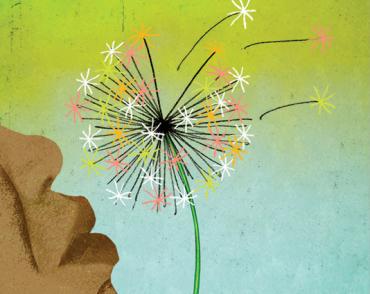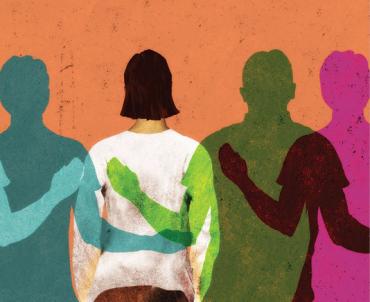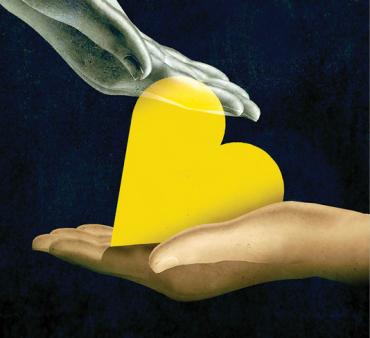The first step in providing support to children and teens exposed to trauma and adversity is helping them to feel safe at school and demonstrating alternative working models of relationships. By spending time in a supportive classroom, students can learn that school can be a safe place, and that teachers and peers can be caring, thoughtful people who are supportive and have their best interests at heart. Under these conditions, the school and the people in the school can serve as alternative attachment figures. This is not to say that teachers become their surrogate parents and that their peers become surrogate siblings. Teacher-student and student-peer relationships are different from family relationships, but they can serve a similar function by helping trauma-exposed kids develop new models of relationships and new models of the self in relation to others.
As human beings, the most important factor for our survival has been supportive relationships. We are strongly motivated to be accepted as part of a community that recognizes our value and provides opportunities to contribute and receive. We evolved to be part of families and communities composed of individuals who care for one another. Without these bonds, human beings would not have survived or flourished as we have. However, today we are losing touch with these bonds. Trauma and adversity disrupt the development of attachment bonds that children need to develop their full potential. Our families and communities are fragmented. It’s harder for children and teens to find alternative attachment figures to connect with, leaving many kids unmoored. There are growing numbers of children left without homes and caregivers due to the opioid crisis.1 Furthermore, large numbers of refugee children and teens fleeing from severe hardship and war are entering our schools with special needs; many of them arrive unaccompanied by parents and require foster care.2
In this article, which is excerpted from my book The Trauma-Sensitive Classroom: Building Resilience with Compassionate Teaching, we’ll explore how to build caring relationships with trauma-exposed students and how to help them build positive relationships with their peers. Admittedly, this is no easy task. Trauma-exposed students may interfere with classroom learning, which can be frustrating. Helping them can be particularly challenging because they may have difficulty trusting peers and adults, especially authority figures. They may be overly defensive, anticipating adult criticism, or defiant, as a way to assert control. Because trauma interferes with the development of relationship skills and emotion regulation, they often find themselves in conflict with peers, either victims or perpetrators of bullying. Educators also need to be aware of children who tend to dissociate and become invisible as a way to cope in social situations, leading to social isolation.
How Teachers Help Build Resilience
Clearly, traumatized students can behave in ways that may disrupt and interfere with teaching and learning. However, when we realize that their behavior—especially, lack of self-control—is a symptom of the trauma, we can begin to understand them and provide them with the support they need.
What can we, as their teachers, do? In 1998, two researchers of child development published a landmark review article of studies of children exposed to trauma and adversity.3 They wanted to better understand why so many children develop competency despite exposure to adverse conditions. They found three important factors associated with resilience among all children and teens, both those normally developing and those considered at risk. The factors are:
- A strong parent-child relationship, or a strong relationship with a surrogate caregiver who serves as a mentor if a parent is unavailable;
- Good cognitive skills, which are predictors of academic success and lead to prosocial behavior; and
- The ability to self-regulate emotions, attention, and behaviors.
While exposure to trauma and adversity can impair these three factors, bolstering them can help students become successful. This is why it is so important to help these children and teens acquire the underlying skills they need to function in school. Doing so will not only help them perform better academically, it will also help them heal from the effects of trauma and adversity.
Teachers and other school staff are well positioned to support these children and teens.
* If the extended periods of time students spend in school take place in a safe, calm, and predictable learning environment, with adults and peers who show care and respect toward them, we can help them heal. We can recognize and focus on areas of strength and build upon them. We can partner with families to strengthen students’ relationships with their caregivers and promote self-regulation skills so they can achieve their academic potential.
In order to be an effective teacher for these students, a mind shift is needed. When a student exhibits difficulties, the tendency is to ask, “What’s wrong with him?” When you find yourself doing this, shift the question to: “What happened to him and how did he learn to adapt to it?” This will help you understand where he is coming from and how best to help him. One thing not to do is to ask him to explain himself by asking, “Why did you do that?” His behavior is likely as perplexing to him as it may be to you!
The Importance of Teacher Support
Years of research have shown that a connection with a sensitive teacher can shape the healthy working relationships children normally acquire in their relationships with loving and consistent caregivers, especially for students exposed to multiple risk factors.
4 Social learning theory, which proposes that people learn from one another by observation, imitation, and modeling, has been applied to understanding how teachers’ emotional support can have positive impacts on older students.
5 Teachers become role models of healthy social and emotional behavior for teens to emulate. In this way, a teacher’s social support can promote healthy emotional skills, healthy relationships, and motivation to learn.
Research has found three crucial dimensions of teacher-student relationships among elementary-aged students: closeness, conflict, and dependency.6 Closeness refers to the degree of positive emotion and warmth the teacher and student express to one another and is associated with positive academic and behavioral outcomes. Conflict refers to the expressions of negative emotion and lack of rapport between the teacher and student and is associated with poor academic and behavioral outcomes. Dependency refers to the extent the student clings to the teacher or demonstrates possessiveness, also associated with poor outcomes. Dependency has also been associated with attachment disorders and requires extra sensitivity from the teacher for the child to engage in meaningful learning activities.7
The critical dimensions of teacher-student relationships at the higher grades are perceived support, utilization, and a sense of relatedness.8 Perceived support is the students’ perception that the teacher is sensitive to their needs and supportive. Utilization is reflected in the willingness of students to rely on the teacher for help. A sense of relatedness is reflected in the extent to which students feel successful in their bids for belonging and acceptance. All three are associated with desirable academic and behavioral outcomes in adolescence. Similar to healthy attachment relationships between children and parents, these relational dimensions between teachers and students give students a sense of security and the safety to explore and engage in learning, which can involve risks.
While there is evidence that children who enter school with insecure attachments have difficulty in their relationships with teachers, this is likely only true in cases where teachers are not highly sensitive. Researchers found that when teachers were highly sensitive, children with less secure attachments were not at risk for developing less close relationships with teachers.9 Unfortunately, exposure to a less sensitive teacher in the early years can lead to years of relationship problems with teachers, as the quality of teacher-student relationships seems to be fairly stable. In other words, if a child has a difficult relationship with his kindergarten teacher, he is more likely to continue to have difficult relationships with future teachers.10 This research points to the critical importance of the quality of teacher-student relationships in early childhood.
What Is Emotional Support?
An important predictor of positive teacher-student relationships is teachers’ emotional supportiveness. What does this look like in the classroom and how can we cultivate it in our relationships with our students? Bob Pianta, dean of the Curry School of Education, where I work, was one of the first to study teacher-student relationships and interactions. He developed an observational measure called the Classroom Assessment Scoring System (CLASS), which is now a widely used and well-validated rating scale designed for applied research on teacher-student interactions.11 This measure is organized according to three latent categories of teacher-student interactions: class organization, instructional support, and emotional support. Classroom organization focuses on interactions associated with classroom management. Instructional support focuses on interactions that support academic instruction. In the "Understanding Emotional Support" box (at right), I focus on the emotional support domain, which is composed of four dimensions: Positive Climate, Negative Climate, Teacher Sensitivity, and Regard for Student Perspectives. A classroom rated high on the domain of emotional support would score high on Positive Climate, Teacher Sensitivity, and Regard for Student Perspectives, and low on Negative Climate.
How Teachers Can Build Caring Relationships
As the teacher, you are the social leader of the classroom, and your students will follow your lead when it comes to relating to other students in the classroom. This is why it’s very important to model the kinds of interpersonal interactions you want them to engage in. I spent 15 years supervising student teachers enrolled in a teacher education program. During this time, I learned much about how teachers’ classroom behavior can build or impair relationships with their students. No teacher intentionally sets out to create negative relationships with students; it happens unintentionally. However, once a teacher and student have begun to engage in a coercive cycle of negative interactions, it becomes a model for the other students to follow.
Model Respectful Interactions
In one classroom I visited, Ms. Rohan was introducing her fifth-grade students to a new novel. As she gave them an overview of the author and the background of the story, she noticed that Joey was fiddling with a piece of paper on his desk. She became visibly annoyed and sharply told him to stop. It was obvious that there was already tension between the two of them, and I could see that Joey was not going to stop, primarily because she had called him out so publicly, and he was embarrassed. I was right: he kept fiddling, and Ms. Rohan became more frustrated. Finally, she went up to his desk, grabbed the piece of paper he was fiddling with, and threw it in the garbage.
This is an example of a power struggle. Ms. Rohan’s relationship with Joey was already strained, and she was primed to overreact. What he was doing wasn’t really a big deal, and when it started out, it wasn’t an intentional attempt to disrupt class and make Ms. Rohan unhappy. But because of her preconceived idea, she assumed that his behavior was intentional, which increased her frustration and triggered her overreaction. When she told him to stop, she publicly shamed him, which made him want to dig in his heels to save face. She finally took the upper hand by grabbing the paper on his desk and throwing it away.
If a student had grabbed a piece of paper from another student and thrown it away, what would we think? That she was a bully? That she was invading his space and taking something that didn’t belong to her? When we act as if the rules don’t apply to us, we send the message to students that might makes right; we are basically modeling bullying behavior. When students observe teachers treating a fellow student this way, two things can happen. First, the students learn that the fellow student doesn’t deserve their respect. If the teacher doesn’t respect him, why should they? They will begin to treat the student the same way as the teacher, possibly taking things, too, and being overly critical and judgmental of him. The second thing that happens is that the students learn not to trust the teacher, thinking, “If she does that to Joey, she might do it to me, too.” Students who already feel less than safe feel frightened.
As you interact with your students, make sure you follow your own rules. Treat each student with respect and kindness. If you find yourself becoming annoyed, work to calm yourself down so that you don’t unintentionally rupture a relationship and trigger a power struggle.
Cultivate Supportive Peer Relationships
Besides serving as a model of social behavior, teachers influence classroom social dynamics directly and indirectly. They can take actions to manage or change the social network patterns of their classrooms, or they can indirectly affect the network patterns through general teaching practices. New research has shown that teachers can affect a classroom’s social status patterns, such as peer norms and status hierarchies, and social affiliation patterns, such as informal peer groups and friendships, which can dramatically affect the classroom climate.12 In fact, just being more aware of the social networks can have a positive effect on your classroom. For example, peer norms against aggressive behavior are stronger when teachers’ reports of their classroom peer networks are more accurate.13
You can tune in to your class as a social group by occasionally stepping back and mindfully observing during a time when your students have some choice about their social dynamics directly and indirectly. Imagine you are observing this group of students for the first time. How are they grouping themselves? Who’s being victimized by whom? Who’s left out? Who is leading the pack?
In a large longitudinal study of elementary classrooms, researchers examined peer networks and teachers’ attunement with their classrooms’ peer networks.14 They also asked the teachers what active measures they took to manage the friendships, aggression, and social hierarchies in their classrooms. The researchers classified these measures as follows: mitigating status extremes, supporting isolated children, managing aggression, and promoting positive behavior. Finally, they observed the teachers’ classroom interactions and rated them using the CLASS measure described above.
They found that teachers who use “more active” strategies to manage friendships, aggression, and hierarchies have students who show “more positive” patterns in their social behavior and their academic adjustment across the school year. These effects were stronger if the teacher was also rated as “more responsive” and found to be “more attuned” to the social network dynamics of her or his classroom. Generally, teachers in this study reported working to reduce the status extremes in their classrooms by providing many alternatives for obtaining status, such as creating opportunities for low-status children to receive recognition, or by reducing the importance of status altogether. The more teachers reported taking active measures, the more their students reported feeling a stronger sense of peer community, higher levels of bonding with the school community, and enjoyment of learning by the end of the school year. One notable finding was that teachers who worked to support friendships, especially for children who seemed isolated, had students who reported a stronger sense of peer community. This research provides us with clear evidence that the active measures we take to improve classroom climate can be very effective and can support our trauma-exposed students.
Patricia A. Jennings is an associate professor in the Curry School of Education and Human Development at the University of Virginia. A former preschool and elementary school teacher, her research and teaching focus on social and emotional learning and mindfulness in education. This article was excerpted from her book The Trauma-Sensitive Classroom: Building Resilience with Compassionate Teaching (W. W. Norton & Company). Reprinted by permission of the publisher. Copyright 2019 by Jennings.
Endnotes
1. U.S. Department of Health and Human Services, Administration for Children and Families, “Number of Children in Foster Care Continues to Increase,” press release, November 30, 2017, www.acf.hhs.gov/media/press/2017/number-of-children-in-foster-care-cont….
2. T. M. Crea et al., “Moving Forward: Educational Outcomes for Unaccompanied Refugee Minors (URM) Exiting Foster Care in the United States,” Journal of Refugee Studies (2017): 1–17.
3. A. S. Masten and J. D. Coatsworth, “The Development of Competence in Favorable and Unfavorable Environments: Lessons from Research on Successful Children,” American Psychologist 53, no. 2 (February 1998): 205–220.
4. T. J. Sabol and R. C. Pianta, “Recent Trends in Research on Teacher-Child Relationships,” Attachment & Human Development 14, no. 3 (2012): 213–231.
5. E. A. Ruzek et al., “How Teacher Emotional Support Motivates Students: The Mediating Roles of Perceived Peer Relatedness, Autonomy Support, and Competence,” Learning and Instruction 42 (April 2016): 95–103.
6. R. C. Pianta, Student-Teacher Relationship Scale: Professional Manual (Odessa, FL: Psychological Assessment Resources, 2001).
7. J. L. Spilt, E. Vervoort, and K. Verschueren, “Teacher-Child Dependency and Teacher Sensitivity Predict Engagement of Children with Attachment Problems,” School Psychology Quarterly 3 (September 2018): 1–10.
8. Ruzek et al., “How Teacher Emotional Support Motivates Students.”
9. E. Buyse, K. Verschueren, and S. Doumen, “Preschoolers’ Attachment to Mother and Risk for Adjustment Problems in Kindergarten: Can Teachers Make a Difference?,” Social Development 20 (February 2011): 33–50.
10. E. O’Connor and K. McCartney, “Examining Teacher-Child Relationships and Achievement as Part of an Ecological Model of Development,” American Educational Research Journal 44 (2017): 340–369.
11. R. C. Pianta, K. M. L. Paro, and B. K. Hamre, Classroom Assessment Scoring System (CLASS) Manual, K–3 (Baltimore: Paul H. Brookes, 2008).
12. S. D. Gest et al., “Teacher Management of Elementary Classroom Social Dynamics,” Journal of Emotional and Behavioral Disorders 22 (February 2014): 107–118.
13. J. W. Neal et al., “Seeing Eye to Eye: Predicting Teacher-Student Agreement on Classroom Social Networks,” Social Development 20 (May 2011): 376–393.
14. Gest et al., “Teacher Management.”




